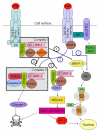Human tumour necrosis factor: physiological and pathological roles in placenta and endometrium
- PMID: 19027157
- PMCID: PMC2974215
- DOI: 10.1016/j.placenta.2008.10.012
Human tumour necrosis factor: physiological and pathological roles in placenta and endometrium
Abstract
The cytokine tumour necrosis factor alpha (TNF) is a well known member of the TNF superfamily consisting of at least 18 ligands and 29 different receptors involved in numerous cellular processes. TNF signals through two distinct receptors TNFR1 and TNFR2 thereby controlling expression of cytokines, immune receptors, proteases, growth factors and cell cycle genes which in turn regulate inflammation, survival, apoptosis, cell migration, proliferation and differentiation. Since expression of TNF was discovered in amnion and placenta many studies demonstrated the presence of the cytokine and its receptors in the diverse human reproductive tissues. Whereas TNF has been implicated in ovulation, corpus luteum formation and luteolysis, this review focuses on the functions of TNF in human placental, endometrial and decidual cell types of normal tissues and also discusses its role in endometrial and gestational diseases. Physiological levels of the cytokine could be important for balancing cell fusion and apoptotic shedding of villous trophoblasts and to limit trophoblast invasion into maternal decidua. Regulation of the TNF/TNFR system by steroid hormones also suggests a role in uterine function including menstrual cycle-dependent destruction and regeneration of endometrial tissue. Aberrant levels of TNF, however, are associated with diverse reproductive diseases such as amniotic infections, recurrent spontaneous abortions, preeclampsia, preterm labour or endometriosis. Hence, concentrations, receptor distribution and length of stimulation determine whether TNF has beneficial or adverse effects on female reproduction and pregnancy.
Figures



References
-
- Pennica D, Nedwin GE, Hayflick JS, Seeburg PH, Derynck R, Palladino MA, et al. Human tumour necrosis factor: precursor structure, expression and homology to lymphotoxin. Nature. 1984;312:724–9. - PubMed
-
- Old LJ. Tumor necrosis factor (TNF) Science. 1985;230:630–2. - PubMed
-
- Aggarwal BB, Aiyer RA, Pennica D, Gray PW, Goeddel DV. Human tumour necrosis factors: structure and receptor interactions. Ciba Found Symp. 1987;131:39–51. - PubMed
Publication types
MeSH terms
Substances
Grants and funding
LinkOut - more resources
Full Text Sources
Medical

